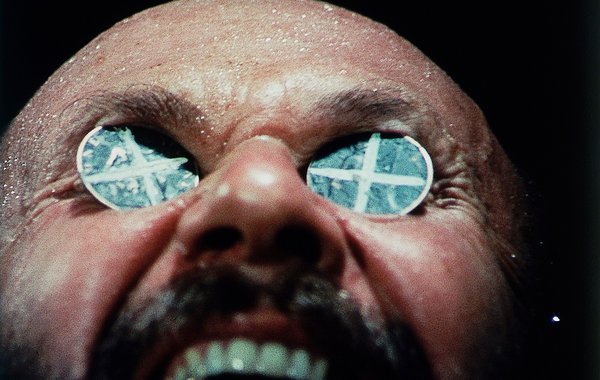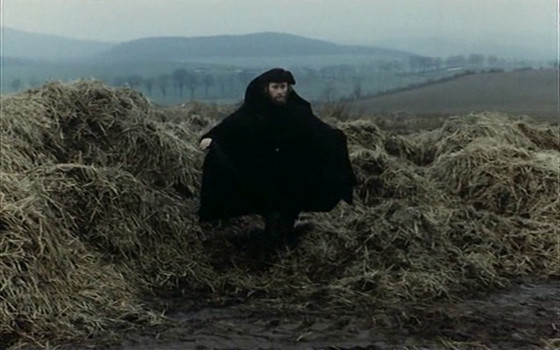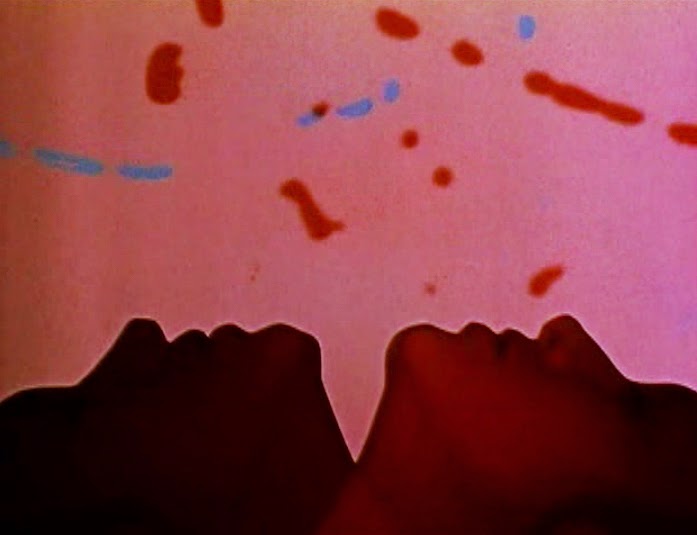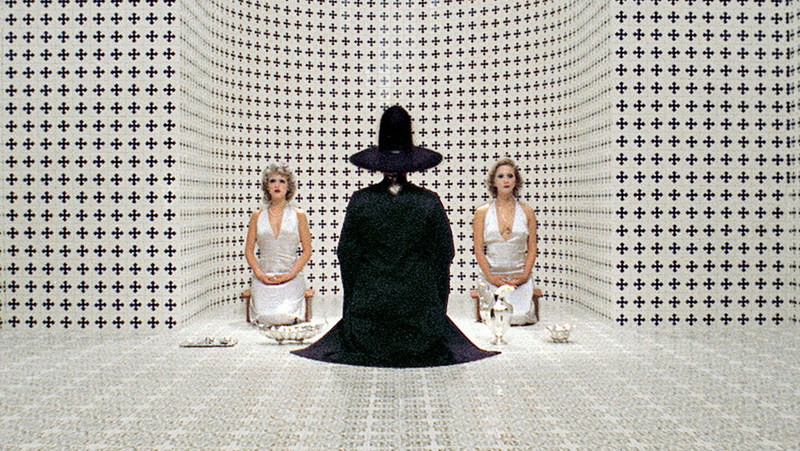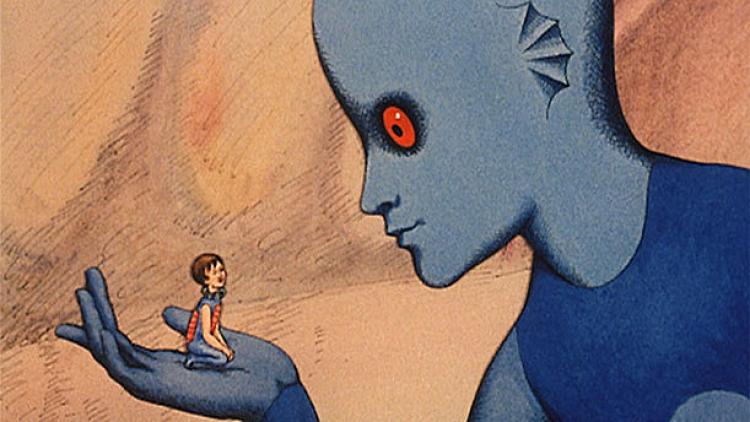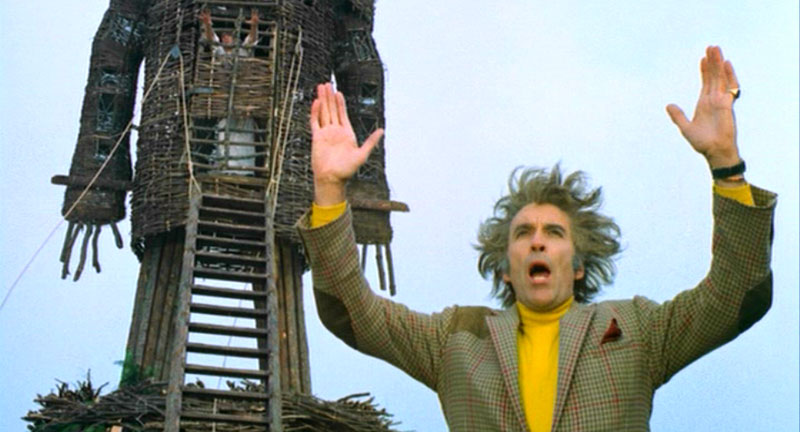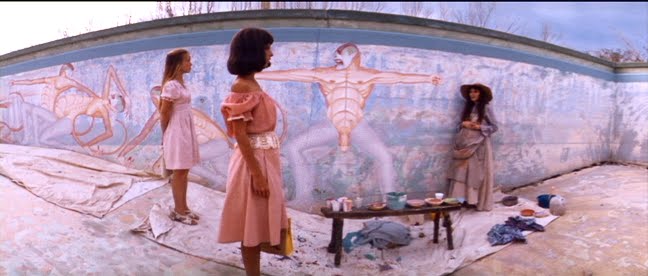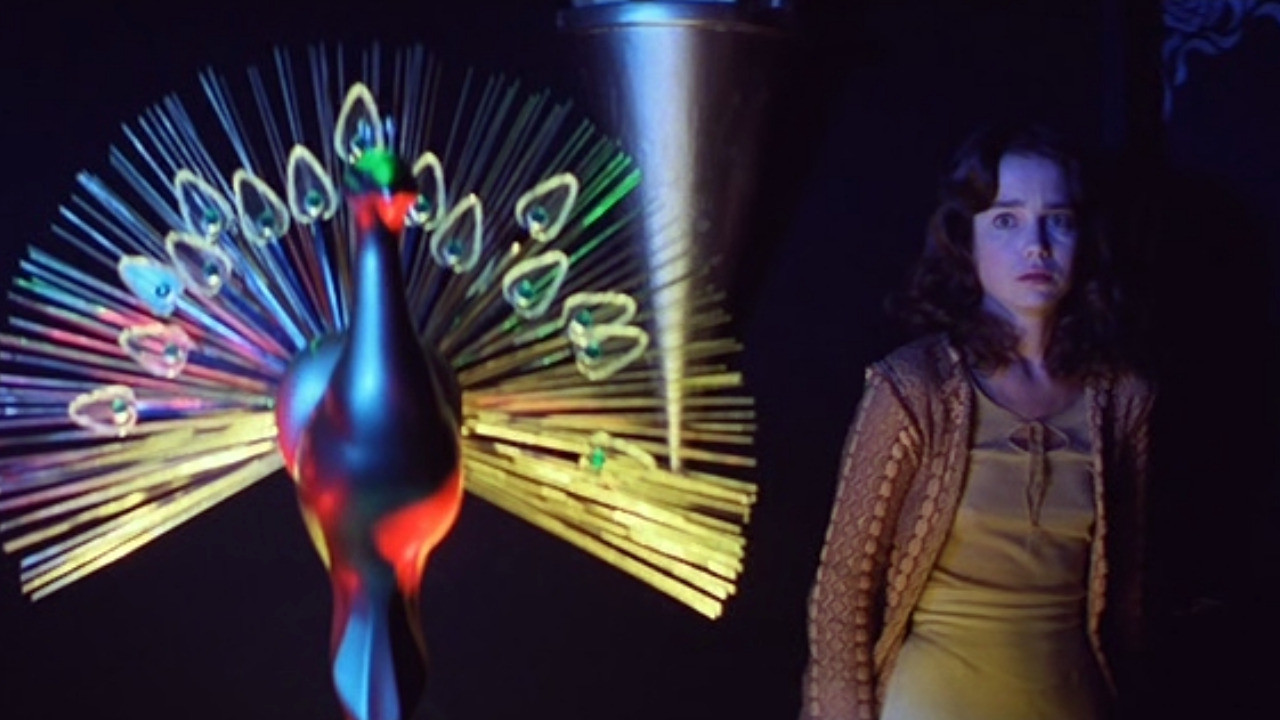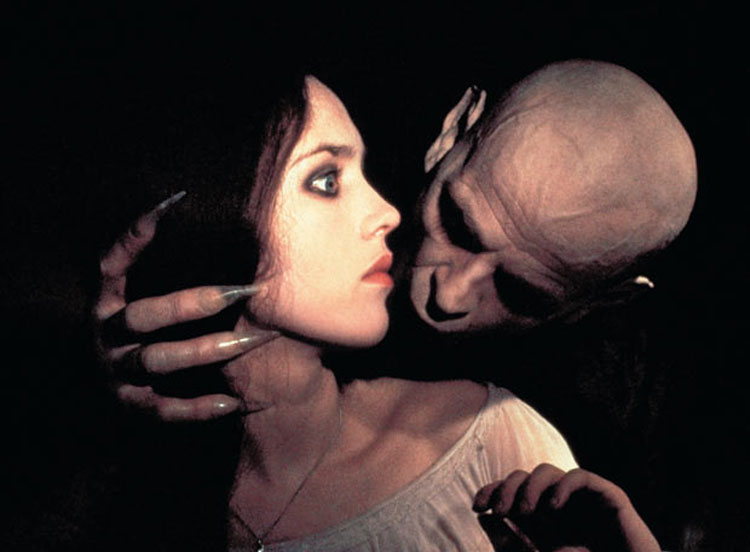9. Wake in Fright (1971) dir. Ted Kotcheff
A relatively unnoticed 1971 Austrialian film, which was only recently restored in 2009 and released by Drafthouse Films, Wake in Fright is a nightmarish slice of life set in a barren small town in Australia. With its psychological, eerie tone (evoking an episode of The Twilight Zone), it puts the viewer in the mind of John Grant (Gary Bond), the film’s protagonist, as he slowly succumbs to his fate within “the Yabba.”
John Grant is a school teacher in the tiny town of Tiboonda in the Austrialian Outback, who is eager to travel to Sydney to meet his girlfriend over Christmas Break. With luggage in hand he gets on a bus to Bundanyabba (affectionately nicknamed “the Yabba” by its inhabitants), in order to fly to Syndey the next morning.
During his night there, John is immediately struck by an indefinable strangeness of the town. He is beckoned to join the drunken stupor that characterizes the town’s male population by the forceful friendliness of Jock Crawford (Chips Rafferty), a local policeman.
After a few drinks, John participates in the town’s favorite gambling game, to which he loses all his money, and his ticket out of the Austrialian Outback. Taken under the wing of Doc Tydon (Donald Pleasence), a self aware cynic and (the town’s only intellectual), John is driven to the point of desperation and the brink of insanity in his dusty prison.
The film’s moody tone as well as the superb characterization of life in an empty mining town puts the viewer in same psychological state of despair as John Grant. His intermittent daydreams, fantasies, and drunken hallucinations give us insight into his mind as we see and feel first-hand how his hopes are crushed by the stark desolation of the Yabba.
10. The Devil (Diabel) (1972) dir. Andrzej Żuławski
Żuławski takes his viewer to the roots of insanity through his passionate saga vividly illustrating the monstrosties of war. The sensational performances and dynamic camera work take the audience on an emotional rollercoaster through the depths of hell.
Amid the Prussian Invasion of Poland in 1793, a Polish nobleman named Jakub is imprisoned in a destroyed monestary turned hospital/jail/insane asylum. A mysterious, diabolical stranger on a white horse saves Jakub and the two of them, as well as a silent nun, embark to visit Jakub’s family and friends, whose lives are now crumbling. Jakub is driven to madness by the horrors around him, and with the stranger’s fiendish coaxing, Jakub commits brutal acts of violence (mirroring the all encompassing violence that surrounds him).
Originally banned in Poland upon release, Żuławski’s film delves into the shattered psyche of the inhabitants of war ravaged Poland. There are no understated emotions in Żuławski’s film; every character in the film goes through hysterical fits of rage, devastation, and/or lunacy. With the emotional extremes expressed by the characters, the disorienting camera work (that includes POV shots and handheld roving shots), and the wild, lo-fi musical score, The Devil presents its viewer with the chaotic sensory experience of a living nightmare.
11. Behind the Green Door (1972) dir. Artie Mitchell and Jim Mitchell
This feature-length pornographic film, released during the Golden Age of American porn, is as psychedelic as it is sexy.
A young woman (Marilyn Chambers) is kidnapped and taken to a mysterious location where she is hypnotised and led on stage in front of an audience. In a state of hypnosis, she takes part in a series of erotic performances.
During the sexual activites, the music slows into a ritualistic drone while the images saturate in color and overlap, lulling the audience into a trace-like state. Through the use of color saturation, music, and slow motion, the Mitchell Brothers mimick the state of hypnosis, creating a kinky psychedelic experience.
12. The Holy Mountain (1973) dir. Alejandro Jodorowsky
No psychedelic film list would be complete without a Jodorowsky film. The Holy Mountain, a surreal masterpiece abundant with religious symbology and references to Christianity, Tarot, and Alchemy, takes the viewer on a mind-bending spiritual journey. Like Buñuel’s Un Chien Andalou, the film opens with a symbolic and ritualistic action.
A cloacked figure takes two women dressed like Marilyn Monroe and sheds them of their societal regalia, removing their make-up, stripping them naked, and shaving their heads. Similar to Buñuel’s slicing of the eye, Jodorowsky is making a symbolic statement to the audience, to shed themselves of their societal standards and cultrually biased values. He then presents to the viewer a film that follows one man, known as the Thief (Horacio Salinas), and his mystical odyssey.
A Christ-like figure, the Thief, is found laying in pile of mud and garbage by a little person without hands or feet. The two go into town, where the people are performing a kind of religious ceremony, carrying crucified dogs while simutaneously executing groups of people, to the entertainment of tourists.
After the people of the town make a wax cast of his body for their mass-produced sculptures resembling Christ, the Thief journeys up a mysterious red tower and meets an Alchemist (Alejandro Jodorowsky), who leads the Thief on a path of enlightenment.
Jodorowsky has a way of creating original religious iconography. His film uses entracing music, symbolic characters, and surreal visuals in order to dissociate the viewer from common religious beliefs and typical cultural values. Jodorowsky immerses the viewer in his own world, an amalgam of mystical philosophies.
13. Fantastic Planet (La Planète sauvage) (1973) dir. René Laloux
This French/Czechoslovakian animated film introduces a strange, alien world in which tiny humans are governed by large humanoid creatures within a desert landscape brimming with monstrous exotic animals. This psychedelic science fiction adventure enmeshes the viewer into its bizarre microcosm.
In this realm, humans, known as Oms, live in tribes in the wild, while the large blue humanoid creatures with unblinking red eyes, known as Traags, control the planet. One day, a few young Traags are playing with an Om and her infant child. Things get a little rough and the Om is killed, leaving her orphan son.
A young Traag named Tiwa is passing by with her father and asks to take the baby Om home as a pet, to which her father agrees. Tiwa raises her pet Om, naming him Terr, and begins to form a strong bond with him. As Tiwa recieves her daily lessons through a portable headset, Terr listens and discovers the history behind Oms and Traags. He escapes with the headset, joins a group of Oms, and educates them, leading to an Om uprising.
Laloux’s imaginative story serves as a socio-political allegory, perhaps alluding to the Soviet forces controlling Eastern European states at the time. Regardless, the creative cut-out stop motion animation, with its foreign landscape, freakish creatures, and occasional hallucinagenic movement creates an eccentric head trip of a film.
14. The Wicker Man (1973) dir. Robin Hardy
This 1973 British cult film is experimental at its core as it plays with genre expectations, which baffle its viewer, and create an unusual filmic experience. One part investigative suspense, one part musical, and one part psychological horror, The Wicker Man infuses ancient pagan practices into the story of a police officer uncovering the mystery of a lost Scottish girl.
A young girl named Rowan Morrison is reported missing on a Scottish island called Summerisle and Sergant Howie (Edward Woodward) goes to investigate. Once on the island, Howie, who is a pious Christian saving himself for his wedding night, is shocked by the sacreligious pagan beliefs carried on by the people of the island. They are sexually free and seem to communicate mainly through song. Undetered, Howie attempts to get to the bottom of the Rowan Morrison disapperance, but instead finds himself delving deeper into Summerisle’s traditions of Druidism.
Robin Hardy has no problem experimenting with style in storytelling and genre. The folk music in the film acts as a storytelling device, mainly by issuing information subconciously to the protagonist (and the audience) as to the pagan belief systems that exsist on the island.
The Wicker Man’s soundtrack is well known to folk music fans, and may have influenced later psychedelic folk (a song from the film is included on a Psychedelic Folk compliation A Monstrous Psychedelic Bubble Exploding in Your Mind: Volume 1). Genre in the film is not clear cut, as it experiments with multiple tools from various genres. The aforementioned musical aspects mixed with the unsettling suspense and dark religious undertones yields a compelling and unique movie experience.
15. 3 Women (1977) dir. Robert Altman
Robert Altman’s enigmatic film captures the subtle strangeness of his characters within a destitute desert landscape. The psychedelic aspect of the film comes out in its ethereal tone, which, from start to finish, remains somewhat unsettling. The eerie music combined with the dreamy performances result in an otherworldly feel that sticks with the audience even after the film has ended.
The film begins at a health spa for the elderly and disabled, where Pinkie Rose (Sissy Spacek) is starting work. She meets Millie Lammoreaux (Shelley Duvall), and answers Millie’s ad for a roommate. Somewhat spaced-out, Pinkie struggles to appease Millie, who herself struggles for the attention and popularity she feels she deserves.
The two of them regular a local bar/shooting range where the bar owner, Edgar (Robert Fortier), and his wife Willie (Janice Rule) live. The very pregnant Willie quietly paints ominous murals while Millie vies for the attention of the drunken Edgar. After a failed suicide attempt on the part of Pinkie, the dynamics (and identities) of the women begin to shift.
The film reportedly was inspired by a dream Robert Altman had, which he adapted into a screenplay, and filmed, with the complete financial support of 20th Century Fox due to the director’s reputation. Altman achieves his dream-like state in this film, with its illusive characters, moody music, and exquisite direction.
16. Suspiria (1977) dir. Dario Argento
With its expressionistic production design and creepy soundtrack from Italian prog rock band Goblin, Argento’s cult classic is as trippy as it is eerie.
A young American ballet dancer, Suzy (Jessica Harper), moves to Germany to join a reknown ballet academy. However, upon arrival she realizes something at this school is awry: when she rings the front buzzer for entry, a mysterious woman doesn’t let her in, and that night two women are brutally murdered. After a weird encounter with one of the academy’s servants, Suzy faints. Things only get weirder during the course of the film with a variety of strange occurances and more mysterious deaths.
The film’s striking colors (especially the vivid reds), Art Nouveau-inspired architecture, and chilling musical score create a stylish and frightful hallucination.
17. Nosferatu: Phantom of the Night (1979) dir. Werner Herzog
Werner Herzog’s remake of the classic vampire tale takes the time-honored story to another level with his darkly poetic and hypnotic film. Herzog’s Dracula, played by the fascinating Klaus Kinski, is characterized as more of shriveled old man yearning for love than a fierce blood-thirsty monster. This interpretation of the character gives the film a poetic depth, which along with the trance-like music of Popul Vuh and gorgeous dreamy landscapes makes the film an entracing, meloncholic fantasy.
Jonathan Harker (Bruno Ganz), a real estate agent from Wismar, Germany travels to Transylvannia to meet Count Dracula and finalize the documents for the Count’s purchase of an estate in Wismar. On his travels, he is warned by local townfolk not to venture any further because of rumors that the Count is a vampire. Jonathan brushes them off as superstitious and continues on his journey.
Meanwhile Lucy (Isabelle Adjani), Jonathan’s newly married wife, suffers night terrors that seem to signify to her immanent doom. While doing business at Dracula’s estate, Jonathan’s locket with a picture of Lucy opens, and the ghostly Count becomes enchanted by her image.
Growing increasingly unsettled by the Count’s strange behavior, such as trying to lick the blood off a fresh cut, Jonathan investigates the Count’s castle and finds him asleep in a coffin. Jonathan escapes the castle, but the Count follows close behind, eager to arrive at his newly purchased estate and meet Lucy in person.
Kinski’s expressive moon-faced Count Dracula cross-cut with Adjani’s terrorized Lucy gives the viewer the impression that the two are metaphysically linked, even before they share the screen. This mystical bond the two share add to the dream-like aspects of the film.
The misty landscapes that permeate the film’s cinematography similarly place the viewer within this hypnotic countryside, set to the spellbinding score by the German avant garde band Popul Vuh. Nosferatu: Phantom of the Night is a mystic reverie that transports the viewer into that bewitching limbo between dreaming and wakefulness.
